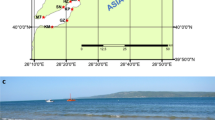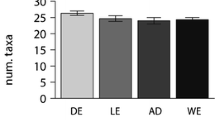Abstract
The architecture of macrofaunal burrows and the total area of the sediment-water interface created by biogenic structure were investigated in the Donggeomdo tidal flat on the west coast of Korea. Resin casting methods were applied to recover burrows of four dominant species, Macrophthalmus japonicus, Cleistostoma dilatatum, Perinereis aibuhitensis, and Periserrula leucophryna, and whole burrows within the casting area at three sites in different tidal levels.P. leucophryna excavated the largest burrow in terms of a surface area among them. In the case of whole burrow casting, the space occupied by the biogenic structure was extended into deeper and expanded more greatly at the higher tidal level. In the uppermost flat, the burrow wall surface area within sediment was more extensive than the sediment surface area. Increased oxygen supply through the extended interface could enhance the degradation rates of organic carbon and also change the pathways of degradation. Quantifying the relationship between the extended interface and mineralization rate and pathway requires more extensive study.
Similar content being viewed by others
References
Aller, R.C. and J.Y. Aller. 1998. The Effects of biogenic irrigation intensity and solute exchange on diagenetic reaction rates in marine sediments.J. Mar. Res.,56, 905–936.
Atkinson, R.J.A., P.G., Moore, and P.J. Morgan. 1982. The burrow and burrowing behaviour ofMaera loveni (Crustacea: Amphipoda).J. Zool. Lond.,198, 399–146.
Atkinson, R.J.A. and R.D.M. Nash. 1990. Some preliminary observations on the burrows ofCallinassa subterranean (Montagu) (Decapoda, Thalassinidea) from the west coast of Scotland.J. Nat. Hist.,24, 403–413.
Bird, F.L. and G.C.B. Poore. 1999. Functional burrow morphology ofBiffarius arenosus (Decapoda: Callianassidae) from southern Australia.Mar. Biol.,134, 77–87.
Bird, F.L., P.I. Boon, and P.D. Nichols. 2000. Physicochemical and microbial properties of burrows of the deposit-feeding Thalassinideam ghost shrimpBiffarius arenosus (Decapoda: Callianassidae).Est. Coast. Shelf Sci.,51, 279–291.
Capehart, A.A. and C.T. Hackney. 1989. The potential role of roots and rhizomes in structuring salt-marsh benthic communities.Estuaries,12(2), 119–122.
Daibers, F.C. 1982. Animals of the tidal marsh. Va n Nostrand Co., New York. 422 p.
Dworschak, P.C. 2002. The burrows ofCallianassa candida (Olivi 1792) andC. whiti (Sakai 1999) (Crustacea: Decapoda: Thalassinidea). p. 63–71. In:The vienna school of marine biology: A tribute to Jörg Ott, ed. by M. Bright, P.C. Dworschak, and M. Stachowitsch. Fäcultas Universitatsverlag, Wien.
Fossing, H., T.G. Ferdelman, and P. Berg. 2000. Sulfate reduction and methane oxidation in continental margin sediments influenced by irrigation (South-East Atlantic off Namibia).Geochim. Cosmochim. Acta,64, 897–910.
Furukawa, Y., A.C. Smith, J.E. Kostaka, J. Watkins, and C.R. Alexander. 2004. Quantification of macrobenthic effects on diagenesis using a multicomponent inverse model in salt marsh sediments.Limnol. Oceanogr.,49, 2058–2072.
Griffis, R.B. and T.H. Suchanek. 1991. A model of burrow architecture and trophic modes in thalassinidean shrimp (Decapoda: Thalassinidea).Mar. Ecol. Prog. Ser.,79, 171–183.
Jørgensen, B.B. 2000. Bacterial and marine biogeochemistry. p.173–207. In:Marine geochemistry, ed. by H.D. Schulz and M. Zabel. Springer, Berlin.
Kostka, J.E., A. Roychoudhury, and P. van Cappellen. 2002. Rates and controls of anaerobic microbial respiration across spatial and temporal gradients in saltmarsh sediments (Sapelo Island, GA, USA).Biogeochem.,60, 49–76.
Kristensen, E. 2000. Organic matter diagenesis at the oxic/anoxic interface in coastal marine sediments, with emphasis on the role of burrowing animals.Hydrobiologia,426, 1–24.
Lee Y.-H. and C.-H. Koh. 1994. Biogenic sedimentary structures on a Korean mud flat: Spring-neap variations.Neth. J. Sea Res.,32(1), 81–90.
Mok, J.S., H.Y. Cho, and J.-H. Hyun. 2005. Rates of anaerobic carbon mineralization and sulfate reduction in association with bioturbation in the intertidal mudflat of Ganghwa, Korea.J. Kor. Soc. Oceanogr. (The Sea),10, 38–46. (In Korean)
Nickell, L.A. and R.J.A. Atkinson. 1995. Functional morphology of burrows and trophic modes of three thalassinidean shrimp species, and a new approach to the classification of thalassinidean burrow morphology.Mar. Ecol. Prog. Ser.,128, 181–197
Nielsen, O.I., E. Kristensen, and D.J. Macintosh. 2003. Impact of fiddler crabs (Uca spp.) on rates and pathways of benthic mineralization in deposited mangrove shrimp pond waste.J. Exp. Mar. Biol. Ecol.,289, 59–81.
Pemberton, S.G., M.J. Risk, and D.E. Buckley. 1976. Supershrimp: Deep bioturbation in the Strait of Canso, Nova Scotia.Science,192, 790–791.
Powers, L.W. and J.F. Cole. 1976. Temperature variation in fiddler crab microhabitat.J. Exp. Mar. Biol. Ecol.,21, 141–187.
Rhoads, D.C. 1974. Organism sediment relations on the muddy sea floor.Oceanogr. Mar. Biol. Ann. Rev.,12, 263–300.
Rosenberg, R. and K. Ringdahl. 2005. Quantification of biogenic 3-D structures in marine sediments.J. Exp. Mar. Biol. Ecol.,326(1), 67–76.
Stamhuis, E.J., C.E. Schreurs, and J.J. Videler. 1997. Burrow architecture and turbative activity of the thalassinid shrimpCallianassa subterranea from the central North Sea.Mar. Ecol. Prog. Ser.,151, 155–163.
Swinbanks, D.D. and J.L. Muternauer. 1987. Burrow distribution of Thalassinidean shrimp on a Fraser delta tidal flat, British Columbia.J. Paleontol.,61(2), 315–332.
Ziebis, W., S. Forster, M. Huettel, and B.B. Jørgensen. 1996. Complex burrows of the mud shrimpCallianassa truncata and their geochemical impact in the sea bed.Nature,382, 619–622.
Author information
Authors and Affiliations
Corresponding author
Rights and permissions
About this article
Cite this article
Koo, B.J., Kwon, K.K. & Hyun, JH. The sediment-water interface increment due to the complex burrows of macrofauna in a tidal flat. Ocean Sci. J. 40, 221–227 (2005). https://doi.org/10.1007/BF03023522
Received:
Revised:
Accepted:
Issue Date:
DOI: https://doi.org/10.1007/BF03023522




